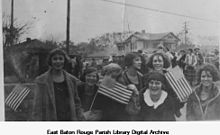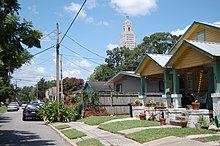Spanish Town, Baton Rouge, Louisiana
This article needs additional citations for verification. (January 2012) |
This article lacks inline citations besides NRIS, a database which provides minimal and sometimes ambiguous information. (November 2013) |

Spanish Town | |
| Location | Bounded by State Capitol Dr., 5th, 9th and North Sts., Baton Rouge, Louisiana |
|---|---|
| Area | 49.4 acres (20.0 ha) |
| Built | 1862 |
| Architectural style | Bungalow/craftsman, Greek Revival, Late Victorian |
| NRHP reference No. | 78001422[1] |
| Added to NRHP | August 31, 1978 |

Spanish Town is a historic district anchored by Spanish Town Road in Baton Rouge, the capital city of the U.S. state of Louisiana.
Spanish Town was commissioned in 1805. Spanish Town holds the title of the oldest neighborhood in Baton Rouge and was added to the National Register of Historic Places in 1978. The community has gone through many developmental changes since its inception, and serves as a "living history" by hosting an assemblage of surviving structures ranging in date from 1823 to 1975. The oldest structure is the Pino House (built 1823).
According to the Baton Rouge State Times (Oct. 18, 1980) "When Galvez Town, twenty miles southeast of Baton Rouge, was ceded in the Louisiana Purchase to the United States in 1803, the Canary Islanders who lived there asked to come to Baton Rouge in order to continue living on Spanish soil. In 1805, Don Carlos de Grandpre (Charles Grandpre), governor of West Florida drew up the layout of an area east of the fort 'out of cannon shot' that became known as Spanish Town."
Home to a virtual hodgepodge of people hailing from many different social classes, this diverse community is home to artists, writers, musicians, actors, students, teachers, physicians, politicians, and attorneys. Spanish Town was at one time particularly renowned for possessing a higher-than-average proportion of gay residents, though this has waned over the years with urban gentrification. However, despite all of these differences, the neighborhood somehow manages to maintain a unique sense of community.
Spanish Town annually hosts the largest Mardi Gras parade in Baton Rouge.
References
External links
30°27′17″N 91°11′03″W / 30.4547°N 91.1842°W

